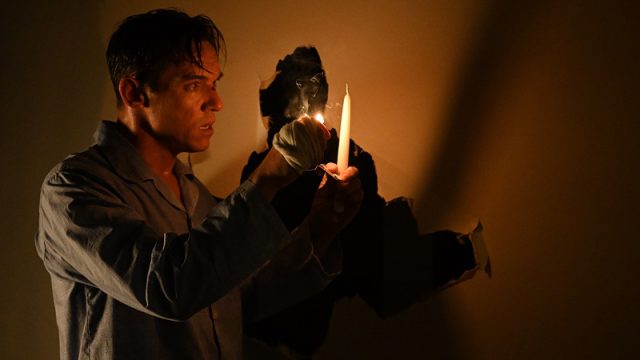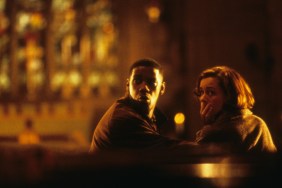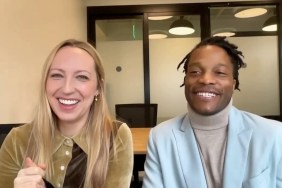Hide and Seek is currently available to rent or purchase on digital platforms, and to commemorate the release, ComingSoon.net spoke with composer Timothy Stuart Jones who discussed his work on the thriller.
Jonathan Rhys Meyers stars in the intense psychological thriller filled with shocking twists and turns. After the death of his wealthy father, Noah seeks his outcast brother to make amends and share the family fortune. But the family harbors a dark secret and a series of cryptic clues will lead Noah on a terrifying trail to the truth that threatens to tear him apart from the ones he loves the most.
Jeff Ames: What led you to become a composer?
Timothy Stuart: When I was a kid I worked on my Dad’s farm in Arizona during the summer break. I saved my money and started buying synthesizers. I was a huge fan of Jan Hammer’s music for the TV show Miami Vice. I was fascinated with the process of marrying music to picture. I didn’t have a way to do it at home, but I read everything I could find about the subject. I would create my own bits of ‘score’ for various moods. Lots of cassette tapes floating around that I would play on my boombox and try to sync up with VHS tapes with the sound off. Keyboard magazine was something I devoured every month. They even had little plastic records you could tear out and put on the turntable. I think the first time I got my hands on a proper synthesizer it was all over. A Roland Juno and it wasn’t mine, but I was hooked. I went to college and started studying music, but it wasn’t until I transferred to a film scoring program at the Berklee College of Music that I really committed to doing this. In high school and early college, lots of people seemed to be fairly certain that there was no way I could make a living in music. They let me know that if you can believe it. That just pissed me off and made me want to do it more. I’m very grateful to those people. That is why I always try to talk to young people about this job when I am asked. Often, it’s the parents who want me to talk to their child. I tell them how hard it is, but I also tell them that chasing a dream is not only possible but pretty damn cool.
RELATED: Cobie Smulders Set for Disney+’s Secret Invasion
Who were some of your main musical influences?
Well, Jan Hammer for one. Depeche Mode was another influence. All that great keyboard work. I’ve been in love with John Williams’ work since I was 7 years old. Later, I discovered Danny Elfman and his Batman and Edward Scissorhands scores. Mozart when I saw Amadeus. I still think he might be my GOAT. I also loved bands like A-ha, Asia, ELO (The tracks they did on the Xanadu soundtrack) will always have a special place for me. Beatles, not the Stones. Sorry, Mick. Jerry Goldsmith was a pillar of film music. I listened to a wide range of things. The Ramones and Devo were in heavy rotation. In college, I was putting all my money into CDs. My Mom told my Dad about it and he was thrilled. He wanted to know what kind of return I was getting on the investments. She said, no honey, compact discs… Hahaha. Poor Dad.
What was it about Hide and Seek that made you want to work on it?
Well, I knew Joel David Moore a little bit and I was very curious to see what direction he was going with it. I had seen the original Korean version and liked it. I thought it would be a fun musical journey. I ended up creating a score to match the grimy world he created for Johnathan Rhys Meyer’s character, Noah. The guy goes off the rails and the music has to follow him. That sounded fun.
What was the most challenging aspect of Hide and Seek and how did you overcome that?
I think time was my biggest enemy on this one. Joel was on the other side of the world filming more Avatar films. It took time to get feedback because of the time difference in New Zealand, and the fact that he already had plenty to do down there. Some of the score was fairly experimental, and I didn’t want to go too far down a road and find out it’s a dead end. Scoring is very subjective. You can talk about music all you like, but in the end, it must be written and evaluated by the filmmaker. I had to work quickly so I could factor in time for getting feedback. It worked out great in the end. There is always a point in the scoring process where it’s clear what the sound of the movie is, and what the score needs to do. It’s a process of discovery. I always spend time with the filmmaker, establishing where the fences are in the ballfield. Once you figure out the musical boundaries, it’s a straighter path for the composer to work and create the score.
You stated you wanted to use a Hitchcockian approach with your music. What does that entail?
Joel and I discussed a score with real edges to it. Sometimes music would hit a cut in the picture hard as we transitioned to a wide shot of New York. A bold brass statement maybe. That is not done as much these days but it seemed to serve the picture. It was a bit anachronistic on purpose with a slightly operatic treatment at times. Joel and I were both happy with it because it gave a sense of size to a movie that was shot primarily inside and in tight spaces. All of that said, we had to reopen the movie a year later and remove most if not all of those moments. I was sorry to see them go as I felt they added something to the drama of the film. However, like I said before, music is highly subjective. Getting score integrated into a film is a collaborative process. It is my job to give the people with the final say what they want and need from the score for their film. However, If I get an opportunity to release the score, I would like to include the original versions of those cues.
Do you have any fun, behind-the-scenes stories about the making of Hide and Seek?
I didn’t have any interaction with the cast on this film. Sometimes I visit the set, but not on this one. I was really just the mad professor in my studio. I worked with a friend to design a lot of sounds and textures for the film. He used things like a swarm of bees that he tuned into a c minor chord. I was able to write music around it. There were also wild parrots flying around my building in the afternoons. They make an enormous racket! My friend recorded them and tuned them up. It was fun to use sounds from the natural world in the score. I think our brains still recognize that they are sounds from animals. Maybe our brains are always sizing up where we are in the food chain compared with the animal sounds we hear around us. I probably should have tuned up a wolf pack. Noticing sounds like that has kept us alive for thousands of years. I think that programming is probably still in there at a very basic level.
What were some of the things you learned from Hide and Seek that you’re excited to apply to future endeavors?
I had a great time mixing the film in 5.1 with my friend and engineer, Ray Plaza. We did some fun things with moving elements around in space. I think a little differently about the writing when I know that certain things are going to be moved to the rear speakers or will pan around the room. In the time since we mixed this film, Dolby Atmos has really started to become more prevalent. The same concepts apply to surround mixing in general, but it’s a quantum leap in what you can do. The Thor: Ragnarok score that I worked on for Mark Mothersbaugh was mixed in Atmos by Alan Meyerson. It was so much fun to hear the music mix in Atmos in the theater.
RELATED: Hawkeye Season 1 Episode 3 Recap & Analysis: ‘Echoes’
What are you most excited for audiences to experience with your score?
I think Joel built some great tension in the film. There are moments when the antagonist is either trying to get into the apartment with the kids or is already there. The music was able to deliver some of those jump scares. I hope the music can pull the viewer into this gritty world and help support the main character as he unravels. When it’s not supporting scares, a lot of the score in this film is about setting the mood for the action.
Do you have any other projects coming up that you can share with us?
I have a film making the festival circuit called, Waterman about the legendary Duke Kahanamoku. He was a 5-time Olympian with multiple gold medals. He is also considered the father of modern surfing. He brought surfing to Australia in 1914. It will be in theaters in Hawaii and California in spring ‘22 and will have a streaming home as well. I’m also starting a film soon called The Hot Seat with director James Cullen Bressack. I’ve never scored a film starring Mel Gibson. I loved the Road Warrior as a kid and I’m looking forward to working on that.









